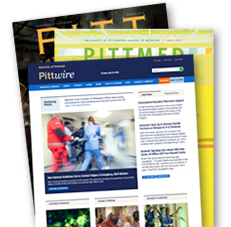Pitt Is the Nation's Top-ranked Public University in the 2009 Edition of Saviors of Our Cities: A Survey of Best College and University Civic Partnerships, Released Today
PITTSBURGH-Pitt is the nation's top-ranked public "Best Neighbor" educational institution in the 2009 edition of "Saviors of Our Cities: A Survey of Best College and University Civic Partnerships".
The top 25 institutions listed in the rankings "were selected because of their positive impact on their urban communities, including both commercial and residential activities such as revitalization, cultural renewal, economics, and community service and development," according to today's announcement of the survey results by Dr. Evan S. Dobelle, the survey's author, who is president of Westfield State College in Massachusetts and former president of the New England Board of Higher Education.
Saying that the current state of the U.S. economy makes the economic relationship between institutions of higher education and their local communities "more important than ever," Dr. Dobelle released the report's findings today in Philadelphia during the 15th annual conference of the Coalition of Urban and Metropolitan Universities. When ranked with all institutions of higher education, public and private, Pitt was tied for second place in the survey with the University of Dayton; the University of Pennsylvania and USC were tied for first place in the survey. Pitt is the only public institution among these four universities.
"The people of Pitt always have been proud to claim Pittsburgh as our home and have worked hard to create and support programs that add to the economic strength, social vitality, and overall attractiveness of the community," said Pitt Chancellor Mark A. Nordenberg. "Over the course of recent years, the role that our University has played in this region's rebirth has been cited with envy by observers from other parts of the country. To now be ranked as the country's very 'best neighbor' among all of the nation's public universities in the 'Saviors of Our Cities' survey is a wonderful form of recognition for those efforts and their impact."
This is the second Saviors of Our Cities" ranking; in the first, issued in 2006, Pitt was ranked 6th among public institutions and 18th among all schools, public and private.
The "Saviors of Our Cities" rankings "are composed of academic institutions diverse in size, geography, and course offerings," according to the announcement of the survey results. "They have demonstrated and documented long-standing cooperative efforts with community leaders to rehabilitate the cities around them, to influence community revitalization and cultural renewal, and to encourage economic expansion of the local economy, urban development, and community service."
Among the criteria for assessment in the survey were length of involvement with the community; real dollars invested; the presence felt through payroll, research, and purchasing power; faculty and student involvement in community service; continued sustainability of neighborhood initiatives; quantifiable increase in positive recognition of the institution; qualitative esprit of the institution in its engagement; and recognition of the impact of these institutions within their communities.
In the published survey text, Dr. Dobelle stated, "Pitt's motto is, 'The city is our campus,' and through an engagement program, which builds upon the historic connection between institution and metropolitan area, the university has played a key role in helping to economically, culturally, and physically revitalize Pittsburgh.
"Working through the U.S. Department of Housing and Urban Development, Pitt created the Community Outreach Partnership Center, which has leveraged the university's resources in a manner which supports neighborhood partnerships in order to address neighborhood concerns. The selection of the city as the site of the 2009 G-20 Summit reflects an urban economy discovering 'life after steel.' PITT ARTS connects the university's students with the city's emerging and energetic art scene.
"Pitt has set the dimensions and pace of engagement in Pittsburgh," Dr. Dobelle concluded. "Its neighborhood collaborations have resulted in physically and economically revitalized neighborhoods. Neighborhood is the key here. Pitt's engagement benefits the entire metropolitan region, one neighborhood at a time."
With respect to the economic criteria considered in the rankings, Dr. Dobelle reviewed the following important elements of Pitt's annual impact on the local economy:
o $5.6 billion in earnings by nearly 74,800 Pitt alumni residing in Allegheny County;
o $1.74 billion in total University-related spending;
o $1.3 billion in personal income generated from nearly 33,800 Pitt-supported jobs;
o $642 million in sponsored research, supporting more than 23,100 jobs;
o $151.7 million in direct and induced expenditures associated with people visiting Pitt;
o $145.2 million to communities, including sales, wage, and real estate taxes; and
o $140.7 million average annual investment on construction from FY 2006 through FY 2008, generating more than 1,300 jobs in construction and related industries.
###
10/12/09/amm
Media Resources
Schools of the Health Sciences Media Relations
For more information about Pitt's schools of dental medicine, health and rehabilitation sciences, medicine, nursing, pharmacy, and public health, click here >
To locate stories from health science schools prior to 2013, visit the UPMC news archives »
Urgent Question?
University of Pittsburgh news reps are available to answer urgent media inquiries. Outside of regular business hours (Mon-Fri, 8:30 a.m.-5 p.m.), please email us at media@pitt.edu.
News reps for University of Pittsburgh Health Sciences schools can be reached outside of regular business hours through the paging operator at 1+412-647-2345.


